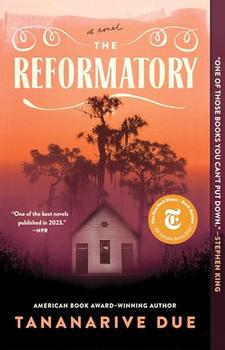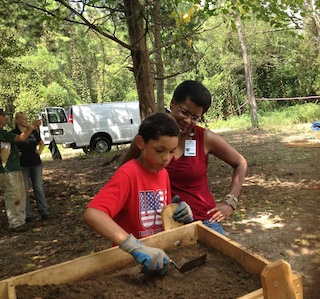Summary | Excerpt | Reading Guide | Reviews | Beyond the Book | Read-Alikes | Genres & Themes | Author Bio

A Novel
by Tananarive DueThis article relates to The Reformatory
 The Reformatory, the newest novel by celebrated author Tananarive Due, tells the horrific story of the Arthur G. Dozier School for Boys. Once the country's largest reform school, Dozier supposedly intended to rehabilitate its students into productive citizens, but instead the boys were terrorized and tortured, and some were even killed (see Beyond the Book for The Nickel Boys). Although deaths at the school were documented between 1914 and 1973, burials at the school's cemetery, known as Boot Hill, were only recorded from 1914 to 1952 and indicate 31 burials on the site during that time. Statements from former inmates, however, suggested that many more boys had died at the school, and in 2011, the state of Florida authorized Dr. Erin Kimmerle to investigate potential additional gravesites on the grounds. Kimmerle, the executive director of the Florida Institute of Forensic Anthropology and Applied Science at the University of South Florida, had experience locating, recovering and identifying remains in mass graves.
The Reformatory, the newest novel by celebrated author Tananarive Due, tells the horrific story of the Arthur G. Dozier School for Boys. Once the country's largest reform school, Dozier supposedly intended to rehabilitate its students into productive citizens, but instead the boys were terrorized and tortured, and some were even killed (see Beyond the Book for The Nickel Boys). Although deaths at the school were documented between 1914 and 1973, burials at the school's cemetery, known as Boot Hill, were only recorded from 1914 to 1952 and indicate 31 burials on the site during that time. Statements from former inmates, however, suggested that many more boys had died at the school, and in 2011, the state of Florida authorized Dr. Erin Kimmerle to investigate potential additional gravesites on the grounds. Kimmerle, the executive director of the Florida Institute of Forensic Anthropology and Applied Science at the University of South Florida, had experience locating, recovering and identifying remains in mass graves.
Over the next few years, Kimmerle's team recovered the remains of 51 individuals in 55 graves—two dozen more graves than indicated by the school's records. Only 13 of those graves were in the Boot Hill cemetery, and even those did not line up with the markers above ground, which had been placed on the graves in the 1990s, decades after the boys were buried. Kimmerle and her team were thus tasked with identifying the remains, ultimately turning to DNA for answers.
Although DNA is unique to an individual, it degrades over time, and nuclear DNA—the type of DNA in cells—is the first type to break down. As these bodies had been buried decades before, their nuclear DNA was largely unusable. However, DNA from their mitochondria, known as mitochondrial DNA (mtDNA) and passed through the maternal line, was still able to be recovered. Kimmerle worked with a group of genealogists to construct family trees of all the boys who had potentially been buried at Dozier, and once the excavations were complete, the USF team began reaching out to maternal family members—some of whom had never heard of the relatives Kimmerle was hoping to identify—to provide the necessary mtDNA samples via cheek swabs. These swabs were subsequently sent to the University of North Texas Health Science Center, where researchers looked for matches between the living DNA and that from the recovered remains. As of 2022, when Kimmerle published We Carry Their Bones, her account of her work at Dozier, 8 boys had been positively identified using DNA analysis.
One of the identified boys was Robert Stephens. Sentenced in 1936 to two years at Dozier for breaking and entering, Stephens made it only 10 months at the school until, shortly after his 15th birthday, he was stabbed to death by another inmate. Stephen's death certificate lists his cause of death as "knife wound following hemorrhage," although it's unclear if an autopsy was performed. Stephens was one of the 31 recorded Boot Hill burials, but his remains had shifted from their original resting place due to flooding and natural erosion and required a DNA match to confirm his identity. A living sample was provided by Stephens's nephew, also named Robert Stephens, who had never previously heard of his uncle. Neither had Tananarive Due, the great-niece of the murdered man.
Like her second cousin, Due had no knowledge of her great-uncle until the Florida Attorney General's Office called and told her about Kimmerle's work. The AG was seeking permission from Due and her relatives to locate and identify Robert's remains for a proper burial; Due not only gave permission, she and her family traveled to Dozier in 2013 for the first day of the USF team's excavations. Due and her nine-year-old son, Jason, helped dig and sift through soil alongside the researchers, hoping to find evidence of their long-lost relative or other boys who had been buried without respect or care. Two years later, Kimmerle called Due to inform her that DNA analysis had positively identified the remains of Robert Stephens, the sixth boy to be identified using DNA, and his remains were released to the family for a formal burial.
Due's discovery of that unknown great-uncle prompted her to write The Reformatory, her way of grieving the lives of the boys who spent time at Dozier as well as giving a different, happier ending to one young boy's life. In all, Kimmerle and her team have documented 98 deaths at Dozier School, and their work has helped provide closure for many families who lost loved ones to the terrors of that place. Their goal to identify remains has been successful only because of DNA analysis, a technique Kimmerle hopes can identify additional victims at Dozier as well as other reformatory schools across the country.
Tananarive Due and her son Jason during the excavation at the Dozier School in 2013, courtesy of Medium
Filed under Medicine, Science and Tech
![]() This "beyond the book article" relates to The Reformatory. It originally ran in November 2023 and has been updated for the
September 2024 paperback edition.
Go to magazine.
This "beyond the book article" relates to The Reformatory. It originally ran in November 2023 and has been updated for the
September 2024 paperback edition.
Go to magazine.
Your guide toexceptional books
BookBrowse seeks out and recommends the best in contemporary fiction and nonfiction—books that not only engage and entertain but also deepen our understanding of ourselves and the world around us.